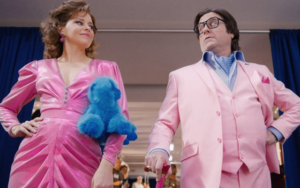THE BEANIE BUBBLE: 3 STARS. “the real story here is one of resilience.”
 By the mid-1990s Beanie Babies, the heart-tagged, soft plush toys with names like Princess Bear and Bubbles the Fish, were not only collected for the fun of it, but also as a financial investment. The world’s first Internet sensation, the rarest of the $5 stuffies could fetch upwards of $500,000 in the collector’s market.
By the mid-1990s Beanie Babies, the heart-tagged, soft plush toys with names like Princess Bear and Bubbles the Fish, were not only collected for the fun of it, but also as a financial investment. The world’s first Internet sensation, the rarest of the $5 stuffies could fetch upwards of $500,000 in the collector’s market.
Before the Beanie consumer craze bubble burst, a lot of people got rich, including creator H. Ty Warner, the subject of “The Beanie Bubble,” a new true crime movie starring Zach Galifianakis and Elizabeth Banks, now on Apple TV+ and in select theatres across Canada.
Loosely based on real events and adapted from Zac Bissonnette’s book “The Great Beanie Baby Bubble,” the film zips back-and-forth between the 1980s and 1990s to tell the story of the three unsung heroes largely responsible for the success of the Beanie Babies.
The story of greed, betrayal and power begins with Warner (Galifianakis), a college dropout looking for the next big thing. He found it with the Beanies, plush toys with cute names, under-stuffed for maximum “pose-ability.” “Genius,” he says with more than a hint of self-congratulation ion his voice, “is 1% inspiration and 99% presentation.”
The cute toys are not, however, an immediate hit. Enter the real focus of the story, executive Robbie (Banks), Ty’s love interest Sheila (“Succession” star Sarah Snook) and innovative tech genius Maya (Geraldine Viswanathan). Here the film splinters, telling the tale of how these three women in three timelines, helped fuel the thermonuclear success of the Beanie Babies.
In each case Warner lured these talented women into his orbit, only to deny them the profits and power their work generated. “Ty will tell you he did it all,” Robbie says. “Which is as crazy as believing stuffed animals are gold.”
Structurally, this breezy look at the inequity women sometimes experience as part of the American Dream, is occasionally confusing as the broken timeline jumps from decade-to-decade, seemingly randomly. But the intercutting between storylines does effectively emphasize Warner’s ongoing abuse, and paints a vivid portrait of how his narcissism shaped not only his life and career, but the lives and careers of those around him.
Galifianakis steps away from his trademarked broad, awkward comedy to play Warner with a certain amount of pathos. That innate sadness, usually masked by a loud bravado, brings some humanity to the character, and prevents him from feeling like an un-filmed subplot from “Horrible Bosses.”
He is the catalyst for the action, but the real story here is one of resilience. The three female characters are discriminated against and struggle for credit and recognition, but each draw on a deep well of determination to create the lives they want. It’s a success story, but not just of the Beanie Babies. The real success here are Robbie, Sheila and Maya who discover their agency.
“The Beanie Bubble” isn’t a business story. The phenomenal success of the stuffed animals is the engine that keeps the story moving forward, but this is really a character-driven tale about people who find a way to balance the inequity in their lives.
